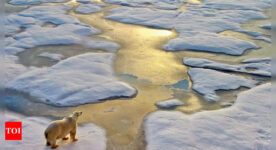
‘Animals have endured domestication to imperialism — no species is truly ‘wild’ today’ | India News
Why do we need to study the history of animals?
■ History is as complicated as the present — the things we consider important today have been so in the past as well. Over time, history has been expanding its acknowledgement of the role different people played in the past — this also means acknowledging the role of other animals. That doesn’t only mean what we humans have done to them but the reciprocal effects animals have had on us. Studying their history is part of getting a more complete understanding of the past — and a more open-minded view of the present.

What have been some decisive turning points in human-animal relations?
■ The biggest one which happened between 5,000 and 10,000 years ago was animal domestication — this was intertwined with people settling down, becoming farmers and human populations increasing. This began a systematic trans formation of our environment. The domestication of the dog had happened earlier but our livestock, mammals and birds were all domesticated in that period.
That moment had profound social and economic consequences for humans — it also transformed the lives of animals, both physically and psychologically. There began a strong selection process among big animals like cattle for individuals who could be easily controlled physically and were also not inclined to attack humans, including in emotional ways. So, while most domestic animals could breed with their wild relatives today, their behaviour is quite different from those who are untamed.

Why did humans domesticate animals purely as pets?
■ That is very hard to say since the archaeological evidence we have does not show us much about the emotional relationships people developed with their animals. Some ties were about collaborative labour, like with plough animals. Some were relationships involving guarding, like with dogs. I find it hard to imagine though that there wasn’t some degree of friendship — hopefully, in both directions — between humans and animals.
In history, pets were first considered a luxury — having a pet was something people of privilege tended to do. If you look at European paintings from, say, the Renaissance period, you often see a dog or a cat sitting with the upper-class person whose portrait is being painted. Having an animal just for pleasure was something people of more modest means started to do around the end of the 19th century.
What were some uses of animals in spreading imperial power?
■ In settler colonies like North America, animals were part of an assemblage, which includes domestic plants, that expedited the transformation of the environment to make this suitable for Europeanstyle farming. This meant these animals competed with indigenous species, including herbivores like deer, and indigenous carnivores like wolves or mountain lions which were seen as a threat to imported livestock — this encouraged the destruction of those wild animals. In East Africa, livestock introduced from Europe brought diseases with them which transmitted to and harmed local animals. Another way imperial power expressed itself was in the animals used in sports hunting while the incorporation of information about animals indigenous to one part of the world was integral to the totalising European knowledge agenda.
What do you include in what you term your ‘anti-imperial bestiary’?
■ In that particular piece of writing, I discussed the quagga — this was a kind of zebra which went extinct both in the wild and captivity in the late 19th century. It wasn’t hunted much as it wasn’t the most spectacular-looking of zebras — it didn’t have very dramatic stripes. However, it competed with livestock for feed and was also killed as food, not for European settlers but their African labourers. Quaggas were wild animals which had been numerous early in the 19th century — and suddenly began to disappear. This was similar to the vanishing of the passenger pigeon in North America and the-near extinction of the American bison. The quagga was an unspectacular victim of imperial economics. It was also an important signal — the quagga was part of what convinced many people about animals being driven to extinction. They knew this about species like the dodo, confined to a small island and not very numerous. But the idea that species which had been numerous and widespread in terms of their territory could disappear so suddenly made people think differently about the impacts of imperial transformation on environments.
Are there still animals on Earth whom we could call ‘wild’?
■ There are some animals who, from their own perspective, could be called ‘wild’ in that they choose to live without interacting with people. However, there aren’t animals today who are ‘wild’ as in their lives being unmodified by human activity — even animals in the Arctic and Antarctic are feeling the impacts of climate change. To say an animal is wild on its terms is different from an animal living a life impacted by human beings.






